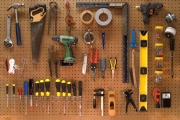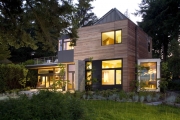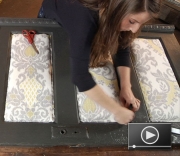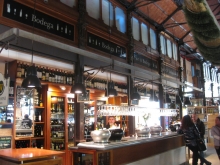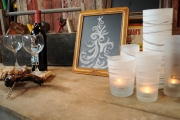- Error
{Re}habitat
Learn how adaptive reuse and upcycling can add hip design to your home, apartment, or yard with the Go Green channel's {Re}habitat series. Follow host Rachael Ranney as she shows you how to repurpose salvaged and found materials, adding fun and function to your space without breaking your budget.

If you really want to get some things done around the house, you will need power tools. Jeff Wilson shares his insights regarding which tools are must-haves.
I always loved shows like Roy Underhill’s The Woodwright’s Shop – by watching I can experience, vicariously, detailed woodworking without power tools. Folks like Roy are truly artisans, and I have tremendous respect for that kind of work.
Green House of the Month: The Ellis Residence by Coates Design
Written by Lisa Taylor Minor Tue Dec 20 2011A Bainbridge Island home represents a marriage of modern aesthetics and sustainability.
When Ed and Joanne Ellis decided to build their dream home on Yeomalt Bluff on Bainbridge Island, Washington, their wish list was threefold: they wanted to create a luxurious yet comfortable space, achieve a high level of sustainability, and help to educate the community on the feasibility of building green without sacrificing beauty.
Find out, step by step, how to upcycle a sturdy wooden door into an upholstered floating headboard. Watch {Re}habitat, Rachael Ranney’s online video series, to learn how adaptive reuse can add fun and function to your space.
Few furnishings add opulent coziness to your bedroom the way upholstered headboards do, but such pieces come with hefty pricetags. Rachael shows how to make an inexpensive and luxurious upholstered floating headboard with a salvaged wooden door, decorative wood trim, and upholstery materials.
At the heart of any city is its marketplace. Madrid remakes some of its classic markets while adding modern twists.
Never one to be outdone by its neighbor Barcelona, Madrid is seeing its own market makeover craze. Two newly refurbished markets have risen from the brink of ruin to become the latest gourmet hot spots – the San Miguel Market and the San Antón Market.
Welcome to the On Site channel’s Construction Administration Column. Unsure of how to handle bond submittals? Here David A. Todd, P.E., CPESC, gives his opinion.
Columnist David A. Todd, P.E., CPESC, has 37 years of experience in the architecture, engineering, and construction (AEC) industry and has performed much construction administration during that time. He will answer questions from our readers or from his own practice and will provide answers based on his understanding of the construction process and administration of the construction contract. The focus will be on the customary duties of the owner, contractor, and design professional as typically described in the contract documents.
Let Rachael Ranney, host of {Re}habitat, help you to upcycle some humble materials into gifts this holiday season. Here are three ideas for inexpensive gifts you can make in a few hours.
In the past few years I have begun to make almost all of my gifts by hand. Not only has it saved me from fighting feverishly through the madness of the pre-holiday mall crowds, it has kept my bank account in good standing. I also manage to give creative, personal, and thoughtful gifts to all of the people on my list.
Measuring is the best way to improve what you are doing. Doing it right is the trick.
Benchmarking is a form of measurement – where you measure something else to see where you are lagging, identify the areas and take corrective action. This is the essence of benchmarking. Incorporate this as part of your Health Check, as discussed earlier.
Green building practices have come on the scene so fast that many implications – and unintended consequences – are just now coming to light. How can you protect yourself, legally speaking, in these new situations?
Environmentally conscious building practices are typically associated with positive outcomes, such as improved energy efficiency, reduced material waste, financial savings as a result of tax incentives, and improved builder reputation. In addition to these benefits, research indicates that certified green buildings cost less to operate; command higher occupancy rates; contribute to a healthier, safer environment; and can possibly enhance employee recruitment and productivity.
